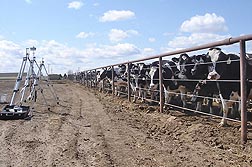This page has been archived and is being provided for reference purposes only. The page is no longer being updated, and therefore, links on the page may be invalid.
| Read the magazine story to find out more. |
|
|
|
|
Dust from Dairies Not Likely to Pose Hazard to Nearby Communities
By Ann Perry
December 12, 2013
Studies by the U.S. Department of Agriculture (USDA) indicate the dust stirred up by wind and restless cattle at dairies does contain bacteria, fungi and small bacterial remnants such as endotoxins. But these potentially problematic particles are not found at high levels far beyond the barnyard.
Agricultural Research Service (ARS) microbiologist Rob Dungan is investigating dispersal patterns and transport of these bioaerosols. ARS is USDA's chief intramural scientific research agency, and this work supports the USDA priority of responding to climate change. Dungan works at the ARS Northwest Irrigation and Soils Research Laboratory in Kimberly, Idaho.
In the western United States, dairy cows are kept in outdoor pens or in a combination of exercise pens and barns at open-freestall facilities. Residents in nearby communities want to know if their proximity to these facilities increases the potential risk of exposure to airborne microorganisms and endotoxins.
In one study, Dungan and his colleagues set up three sampling sites at a 10,000-cow open-freestall dairy to measure airborne endotoxins and culturable microorganisms like bacteria and fungi during fall, spring and summer.
The researchers found that overall average inhalable airborne endotoxin concentrations were 5 endotoxin units (EU) per cubic meter of air 655 feet upwind of the barn—their "background" levels"—and 426 and 56 EU per cubic meter of air 165 and 655 feet downwind of the barn, respectively.
Close to the barn, endotoxin concentrations at night were significantly higher than morning concentrations and similar to afternoon concentrations. The scientists attribute the higher levels to increased animal activity and lower windspeeds during these times. But at the other two sites, endotoxin concentrations did not vary significantly over 24 hours.
Samples of bacterial concentrations showed a similar pattern, with the highest counts—84,000 colonies per cubic meter of air—measured near the barn. The other two sites had less than 8,000 colonies per cubic meter of air. As with the daily endotoxin concentrations, bacterial concentrations near the barn increased significantly at night, but concentrations farther downwind did not.
Results from Dungan's studies have been published in Journal of Animal Science, Environment International, Journal of Environmental Quality, and elsewhere.
Read more about his research in the November/December 2013 issue of Agricultural Research magazine.

